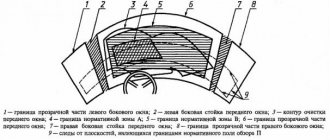The topic of illegal car window tinting is still relevant in 2021. Last spring, a bill appeared to toughen penalties for tinting glass that exceeds the norm. The deputies proposed:
- increase the fine to 1,500 rubles for committing this offense for the first time;
- introduce a new fine of 5,000 rubles for repeated fixation of illegal tinting.
How much is the fine for tinting starting in 2021? Has the new law come into force or not? What kind of tint can you use when driving abroad? You will learn the answers to these questions from our article.
Is tinting prohibited in Russia?
The issue of tinting car windows regularly becomes a topic of lively debate among both car owners and legislators.
Proponents of tinting say that darkening the windows allows you to maintain a comfortable microclimate in the car, and this is especially important in the southern regions of the country. In addition, in their opinion, tinting protects the car from being opened by intruders.
Opponents of tinted glass motivate their point of view by the fact that tinting impairs the driver’s visibility of the road and increases the risk of an accident. They also believe that cars with dark windows are often used to transport illegal goods.
Requirements for the light transmission of car windows are established in the Technical Regulations of the Customs Union TR CU 018/2011 “On the safety of wheeled vehicles” dated December 9, 2011 and in GOST 32565-2013 “National Standard of the Russian Federation. Safety glass for ground transport. General technical conditions" dated November 22, 2013 No. 2008-st.
In accordance with these documents:
- The light transmittance of the windshield must be at least 70%;
- in the upper part of the windshield it is permissible to have a light protection strip no more than 14 cm wide with any degree of darkness; for freight vehicles, buses, trolleybuses and specialized passenger vehicles, the regulation presupposes a different standard: the width of the lane should not exceed the minimum distance between the upper edge of the windshield and the upper boundary of the area where it is cleaned by the wipers;
- windshield tinting should not distort the perception of white, yellow, red, green and blue colors;
- tinting with a mirror effect is prohibited;
- There are no restrictions on rear window tinting;
That is, there is no need to talk about a complete ban on tinting. On the contrary, according to the previously valid GOST 5727-88, the level of light transmission should have been at least 75%, but now the figure has dropped to 70%.
In addition, most modern cars leave the assembly line with tinted windows, so it is very difficult to find a car with 100% transparent windows on the roads.
Why is tinting prohibited?
It is worth mentioning right away that there is a ban on tinting a car not in accordance with the currently approved GOST. You can tint car windows, but subject to certain rules. So, the requirements of GOST 32565-2013 for tinting are as follows:
- the car windshield must transmit at least 70% of the light flux;
- at least 70% of light must penetrate through the front side windows;
- The rear and rear side windows can be darkened depending on the car owner's preferences, provided that there is a view of the road behind the car in two rear-view mirrors.
There are no specific instructions regarding tinting the remaining windows of the car. Consequently, they can be tinted with a film of any light transmittance. There is no mention of the ban on tinting with mirror film in GOST 2013, so “everything that is not prohibited is permitted.”
Car enthusiasts should take into account that modern cars are already produced from the factory with windshield tinting, which has a darkening coefficient of about 10%. Therefore, before tinting the windows on a car, you should find out what kind of shading the car has “natively”, and only after that choose the light transmittance of the future tinting. Do not forget that over time, car glass loses its original transparency and becomes cloudy, i.e. its light transmittance decreases by 20 - 30%. And this is not always visible to the naked eye.
An example of calculating the permissible light transmittance coefficient
Let's assume that the windshield of a car has a shading factor of 10%, that is, it transmits 90% of the light flux.
The permitted dimming rate is 30% (100% - 70%). Therefore, to stay within the established limits, it is necessary to choose a film with a darkening factor = 30% - 10% = 20%. The choice of tint film in this situation should be limited to a darkening rate of 5 to 20%. If the glass is already old, then it transmits only 70 - 75% of the light flux. These are the maximum permissible values. Consequently, in this case we can no longer talk about any tinting.
What are the reasons for such strict rules limiting the tinting of car windows? It is logical to assume that with traffic safety and law enforcement measures. Therefore, the grounds for restrictions on tinting include:
- reduced visibility of the situation on the road for the driver, as a result - the creation of an emergency situation not only for his car, but also for other road users;
- the likelihood of any illegal actions being committed in the car.
The listed reasons are a fairly compelling argument, so strict requirements for tinting rules have a right to exist.
What kind of front window tinting will happen in 2021?
The bill to increase fines, introduced this spring for discussion by deputies, once again did not receive support, and the punishment for tinting remained the same as it was in 2021. We would like to remind you that United Russia has repeatedly come up with a similar initiative.
In accordance with clause 3.1 of Art. 12.5 of the Code of Administrative Offenses of the Russian Federation, driving a car with windows whose light transmission does not meet the requirements of the law is an administrative offense. In this case, the fine for tinting a windshield in 2021 is 500 rubles.
Protocol under Part 3 of Art. 12.5 of the Code of Administrative Offenses of the Russian Federation can be compiled only on the basis of data obtained using a special device - a taumeter. Currently, the most common models are: “Blik” in various modifications, “Tonic”, “Light”.
The traffic police officer who carries out the measurement must have documents confirming the serviceability of the device and its certification.
New fines for tinting 2021 - true or not?
An increase in the fine for tinting has been discussed since back in 2013, when new sanctions were introduced for wearing a seat belt and talking on the phone while driving. And in 2021, there was information about an increase in fines for the most common traffic violations on November 20. This information turned out to be untrue. But now there are opinions that new fines for tinting are expected from January 2021. Whether this is true or not, let's find out!
For now, the sanction for tinted windows includes a fine of 500 rubles.
.
In many cases, there is also the risk of being ticketed for tinting
and even
deregistration of the vehicle
.
New fine for tinting 2021 - true?
No.
This is not true regarding the new legislation specifically from January 2018.
The fine for tinting was 500 rubles and remains equal to this amount. As of January 4, 2021, such punishment is provided for by Part 3.1 of Article 12.5 of the Code of Administrative Offenses
:
3.1.
Driving a vehicle with glass (including glass coated with transparent colored films) whose light transmission does not meet the requirements of the technical regulations on the safety of wheeled vehicles is subject to an administrative fine of five hundred rubles.
The requirements for light transmittance of car windows have not changed either. According to the same Technical Regulations, which also did not change by 2018, light transmittance must be at least 70% for the front hemisphere of observation windows - the front and front side ones.
The rear ones can be tinted at least 100%, provided there are side rear view mirrors.
|
But in the spring of 2021, deputies still plan to return to the issue of increasing the fine for tinting, they reported.
The same old initiative that we mentioned above will be put forward for discussion again - you will have to pay 10 times more for overly tinted front windows. According to the new discussion, it is planned to increase the fine for the first time to 1,500 rubles (versus 500 today). And if you violate it again, you will have to pay 5,000 rubles. As the legislators themselves assure, the likelihood that the new law will be adopted is quite high.
For tinting, in addition to a fine, everyone will also be required to eliminate the offense and cancel the registration. And this is no joke.
If this is your first time hearing about this, let us briefly explain the logic of both security measures:
the traffic police inspector has the right to demand the termination of the offense, it is not even stipulated anywhere that it must be in writing; tinting is a violation that clearly did not occur on the way, therefore the traffic police officer has the right to demand the cessation of further movement with the violation;
termination of registration is allowed to inspectors by the relevant Order No. 1001, paragraph 51 of which states that this procedure is carried out when malfunctions are detected with which control is prohibited.
Penalty for re-fixing tint
Regardless of whether the first time a protocol is drawn up against you for tinting exceeding the norm or the second time, the punishment will always be the same - a fine of 500 rubles. As of 2021, Russian legislation does not have a separate, more serious penalty for repeated commission of this offense.
However, according to Part 1 of Art. 19.3 of the Code of Administrative Offenses of the Russian Federation, a traffic police officer has the right to issue an order to eliminate the offense. That is, when illegal tinting of windows is detected, along with the protocol, an order is issued regarding the need to remove the tinting within a certain period of time (usually within 1-10 days). Information about this is entered into the traffic police database.
If, having stopped the vehicle after the specified period, the inspector again fixes the tint, then a protocol is drawn up against the driver under Part 1 of Art. 19.3 of the Code of Administrative Offenses for disobedience to a lawful order or requirement of a police officer.
The protocol is being reviewed in court. The car owner faces punishment, which can be either a fine not exceeding 1,000 rubles or arrest for up to 15 days.
As judicial practice shows, “malicious” lovers of dark glasses are sent under arrest for a period of 2 to 15 days. Moreover, this trend has developed in many regions of Russia. And when an attempt is made to challenge the Supreme Court, in most cases it takes the side of law enforcement agencies and recognizes the decisions of lower courts as legal and justified.
You can avoid such punishment by removing the film from the glass in the presence of an inspector. Then the traffic police officer will record the fact that the violation has been eliminated, and information about this will be included in the road inspection database.
Is it possible to avoid punishment for tinting?
Even if you have removable tinting, this will not be a reason for the traffic police inspector not to issue a fine, if only for the reason that a violation was recorded. Not only does it cost you money, but you also have to remove the tint film, which also costs money.
Therefore, if you decide to tint your car, it is better to do it all according to the law, which is not prohibited:
- It is allowed to tint the rear window and rear passenger windows;
- it is allowed to install a sun protection strip on top of the windshield from edge to edge, the width of which should not exceed 14 cm;
- It is allowed to install solar control film on the front side windows if the film is capable of transmitting at least 70% of light.
There are car enthusiasts who use mirror film. But they just don’t use it for a long time, since any kind of protection from light is prohibited in principle, on the front windows, on the rear windows, and on the headlights.
Conclusion
To summarize, we can say that the penalty for tinting in 2018 has not changed - for exceeding the permissible light transmittance of glass, a fine of 500 rubles is still provided.
But if the tint is re-fixed, there is a possibility of being prosecuted under Art. 19.3 of the Code of Administrative Offenses of the Russian Federation for failure to comply with the requirements of police officers. And as a result, the punishment for tinting today may turn out to be much more serious than just 500 rubles.
Traffic police fines for tinting: what happened before and what is planned
An active fight against tinted windows began in the early 2000s. In the 2000s these were literally penniless sums - 100 rubles. Because of this formality of punishment, it was often not imposed, but they preferred to release the offenders or give a “final warning.” But this only led to an increase in the risk of road accidents due to limited visibility.
In 2010, it was decided to increase the amount 5 times. The amount of 500 rubles is still relevant. There are no additional sanctions - the inspector cannot deprive the license or increase the fine. However, a new law is planned in 2018, providing for a fine for tinting in the amount of 1,500 rubles for the first violation and 5,000 for a second violation. If the bill is passed, persistent violators will not only be fined, but also deprived of their driver’s license for up to 6 months.
To avoid a fine for tinting, you need to use only coatings with acceptable light transmission, and always remember the driver’s rights.









